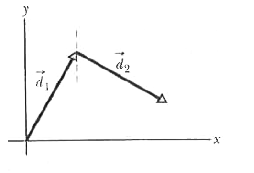A parallelogram is fromed with→a and →b as the sides let →d1 and →d2 be the diagonals of the parallelogram , them a2+b2=
d21+d222
d21+d221
d21+d22
d21−d22
The correct Answer is:A
To solve the problem, we need to establish the relationship between the sides of the parallelogram formed by vectors →a and →b and its diagonals →d1 and →d2.
1. Identify the Diagonals:
In a parallelogram formed by vectors →a and →b, the diagonals can be expressed as:
→d1=→a+→b
→d2=→a−→b
2. Calculate the Magnitudes of the Diagonals:
To find the squares of the magnitudes of the diagonals, we use the following formulas:
|→d1|2=|→a+→b|2=|→a|2+|→b|2+2|→a||→b|cos(θ)
|→d2|2=|→a−→b|2=|→a|2+|→b|2−2|→a||→b|cos(θ)
3. Add the Squares of the Diagonals:
Now, we add the squares of the magnitudes of the diagonals:
|→d1|2+|→d2|2=(|→a|2+|→b|2+2|→a||→b|cos(θ))+(|→a|2+|→b|2−2|→a||→b|cos(θ))
Simplifying this, we find:
|→d1|2+|→d2|2=2|→a|2+2|→b|2
4. Factor Out the Common Terms:
We can factor out the common factor of 2:
|→d1|2+|→d2|2=2(|→a|2+|→b|2)
5. Solve for |→a|2+|→b|2:
Dividing both sides by 2 gives us:
|→a|2+|→b|2=|→d1|2+|→d2|22
Final Result:
Thus, we conclude that:
|→a|2+|→b|2=|→d1|2+|→d2|22
In a parallelogram formed by vectors →a and →b, the diagonals can be expressed as:
→d1=→a+→b
→d2=→a−→b
To find the squares of the magnitudes of the diagonals, we use the following formulas:
|→d1|2=|→a+→b|2=|→a|2+|→b|2+2|→a||→b|cos(θ)
|→d2|2=|→a−→b|2=|→a|2+|→b|2−2|→a||→b|cos(θ)
Now, we add the squares of the magnitudes of the diagonals:
|→d1|2+|→d2|2=(|→a|2+|→b|2+2|→a||→b|cos(θ))+(|→a|2+|→b|2−2|→a||→b|cos(θ))
Simplifying this, we find:
|→d1|2+|→d2|2=2|→a|2+2|→b|2
We can factor out the common factor of 2:
|→d1|2+|→d2|2=2(|→a|2+|→b|2)
Dividing both sides by 2 gives us:
|→a|2+|→b|2=|→d1|2+|→d2|22
Thus, we conclude that:
|→a|2+|→b|2=|→d1|2+|→d2|22
Topper's Solved these Questions
- VECTORSBOOK - GRB PUBLICATIONCHAPTER - VECTORSEXERCISE - MORE THAN ONE CHOICE IS CORRECT
15 Videos
- VECTORSBOOK - GRB PUBLICATIONCHAPTER - VECTORSEXERCISE - ASSERTION- REASON
1 Videos
- VECTORSBOOK - GRB PUBLICATIONCHAPTER - VECTORSEXERCISE - PROBLEMS FOR PARCTICE
23 Videos
- UNITS AND DIMENSIONSBOOK - GRB PUBLICATIONCHAPTER - UNITS AND DIMENSIONSEXERCISE - Link Compression
6 Videos
Similar Questions
If the area of the parallelogram with →a and →b as two adjacent sides is 15 sq unit ,than the area of the parallelogram having, 3→a+2→b and →a+3→b as two adjacent sides in sq unit is
View SolutionShow that area of the parallelogram whose diagonals are given by →a and →b is ∣∣→a×→b∣∣2. Also, find the area of the parallelogram, whose diagonals are 2ˆi−ˆj+ˆk and ˆi+3ˆj−ˆk.
View Solution
Knowledge Check
What is the geometric interpretation of the identity (→a−→b)×(→a+→b)=2(→a×→b)?
1. If the diagonals of a given parallelogram are used as sides of a second parallelogram, then the area of the second parallelogram is twice that of the given parallelogram.
2. If the semi-diagonals of a given parallelogram are used as sides of a second parallelogram, then the area of the second parallelogram is half that of the given parallelogram.
Select the correct answer using the code given belowA1 onlyB2 onlyCBoth 1 and 2DNeither 1 nor 2Diagonals of a parallelogram are respresented by vectors →A=5ˆi−4ˆj+3ˆkand→B=3ˆi+2ˆj−ˆk. Area of the parallelogram is :
A√171unitsB√72unitsC√72unitsD72 unitsStatement 1 : If ∣∣→a+→b∣∣=∣∣→a−→b∣∣, then →aand→b are perpendicular to each other.
Statement 2 : If the diagonals of a parallelogram are equal in magnitude, then the parallelogram is a rectangle.ABoth the statements are true, and Statement 2 is the correct explanation for Statement 1.BBoth the statements are true, but Statement 2 is not the correct explanation for Statement 1.CStatement 1 is true and Statement 2 is false.DStatement 1 is false and Statement 2 is true.
Vectors along the adjacent sides of parallelogram are →a=ˆi+2ˆj+ˆkand→b=2ˆi+4ˆj+ˆk. Find the length of the longer diagonal of the parallelogram.
View SolutionA parallelogram is constructed on 3→a+→band→a−4→b,where|→a|=6and∣∣→b∣∣=8 and →aand→b are anti parallel then the length of the longer diagonal is (A) 40 (B) 64 (C) 32 (D) 48
View Solution(a) In the figure here, what are the signs of the x components of →d1and→d2 ? (b) What are the signs of the y components of →d1and→d2 ? (c ) What are the signs of the x and y components of →d1+→d2 ?

View SolutionABCD is parallelogram →A,→B,→Cand→D are the position vectors of vecticles A, B, C, and D with respect to any origin, them:
View SolutionIf (→a×v→b)×(→c×→d).(→a×→d)=0 then which of the following may be true ?
View Solution
